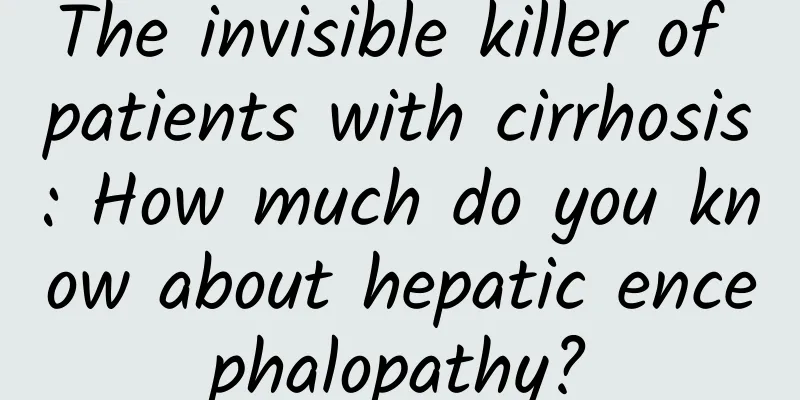The invisible killer of patients with cirrhosis: How much do you know about hepatic encephalopathy?

|
Author: Xie Wen, Chief Physician, Beijing Ditan Hospital, Capital Medical University Reviewer: Wang Lixiang, Chief Physician, Third Medical Center, PLA General Hospital The 10th Chairman of the Science Popularization Branch of the Chinese Medical Association Hepatic encephalopathy, a medical term that may sound unfamiliar, is a serious complication that many patients with cirrhosis have to face. This neuropsychiatric abnormality caused by liver dysfunction not only affects the patient's daily life, but also threatens his or her life safety. 1. What is hepatic encephalopathy? In short, hepatic encephalopathy is a series of abnormal neuropsychiatric symptoms caused by liver dysfunction. This disease occurs when the liver suffers acute or chronic damage, or when there is a shunt, resulting in the inability of substances that should be metabolized by the liver to be processed normally, and then enter the blood circulation, invade the nervous system, and interfere with its normal function. It is particularly important to point out that, although HE is not well known among the general public, its incidence in patients with cirrhosis is quite significant, with a rate as high as 30% or even 80%. This means that more than one-third of patients with cirrhosis may show symptoms of HE to varying degrees, highlighting the prevalence of this complication. Figure 1 Original copyright image, no permission to reprint In addition, the root cause of hepatic encephalopathy lies in the abnormal function of the liver itself. In other words, encephalopathy will only occur when the liver function is impaired and cannot perform its metabolic functions normally. Therefore, the deterioration of liver health is a necessary condition for triggering hepatic encephalopathy. 2. What are the symptoms of hepatic encephalopathy? The symptoms of hepatic encephalopathy are diverse, ranging from mild to severe, and gradually develop, seriously affecting the patient's quality of life and prognosis. In the early stages of the disease, that is, the mild stage, patients with hepatic encephalopathy may only show some mild neurological and psychiatric symptoms. These symptoms are often hidden and difficult to detect, but careful observation can still reveal their clues. Patients may show euphoria, that is, an abnormally pleasant mood, and excessive interest or satisfaction in the surrounding environment or things. At the same time, their counting ability may decline, simple arithmetic operations become difficult, and they may even have disorientation and cannot accurately judge time, place or people. Although these symptoms are mild, they indicate that the patient's liver function has obvious abnormalities. Figure 2 Original copyright image, no permission to reprint As the disease progresses, the symptoms of hepatic encephalopathy patients will become more obvious and severe. In the obvious stage, in addition to the mild symptoms mentioned above, patients may also have some unique signs, such as flapping tremors and ankle clonus. Flapping tremors are manifested as the patient's hands shaking like bird wings when they are raised horizontally; ankle clonus is when the patient is lying flat, the doctor lifts up his knees and moves his feet toward the head with force, and the feet have involuntary tremors. The appearance of these signs often indicates that hepatic encephalopathy has entered a more obvious stage. Figure 3 Original copyright image, no permission to reprint In more serious stages, patients with hepatic encephalopathy may experience drowsiness, that is, they sleep most of the time and their response to external stimuli is weakened. At this point, the patient's level of consciousness has significantly decreased, and they may even fall into a coma. In this case, the patient's life safety will be seriously threatened and emergency treatment is required immediately. In addition, patients with hepatic encephalopathy may also have other non-specific symptoms, such as loss of appetite, nausea, vomiting, abdominal distension and other digestive system symptoms; as well as jaundice, ascites, liver palms, spider nevi and other liver disease-specific signs. The appearance of these symptoms and signs is closely related to the patient's severe liver function disorder. 3. How to treat hepatic encephalopathy? The treatment strategy for hepatic encephalopathy covers multiple levels, from eradication of the cause, nutritional support, symptomatic treatment, and ultimately organ replacement, aiming to comprehensively address this complex pathophysiological process. First of all, etiological treatment is the core. For cirrhosis caused by hepatitis B, antiviral treatment is the key; for alcoholic cirrhosis, complete alcohol abstinence is essential. Although symptoms may occur during the withdrawal process, medical intervention can help it transition smoothly. Nutritional support is also important, because patients with cirrhosis often have poor nutritional status, and reasonable nutritional supplements can help improve overall health. Lowering blood ammonia levels is the top priority of symptomatic treatment, which usually involves intestinal management. Ensure that the patient has smooth bowel movements, use drugs such as lactulose to regulate intestinal pH, optimize the structure of intestinal flora, and reduce the production and absorption of ammonia. In addition, blood ammonia levels can be effectively controlled by adjusting the ratio of amino acids, using short-chain fatty acids, and using drugs such as arginine, potassium glutamate, and sodium glutamate when electrolyte imbalance occurs. For patients with intestinal bleeding, doctors need to strike a careful balance, avoiding new bleeding risks and clearing blood in the intestines in a timely manner to prevent ammonia poisoning. In drug treatment, lactulose and lactitol can reduce ammonia absorption by regulating the intestinal environment and laxative effect, respectively. Amino acid preparations such as aspartic acid and ornithine help ammonia metabolism, and intestinal targeted antibiotics such as rifaximin can adjust the intestinal flora to avoid ammonia production. Currently, microecological preparations are also receiving increasing attention, which can further reduce ammonia production and absorption by improving the intestinal microbial environment. Figure 4 Original copyright image, no permission to reprint Enema therapy can quickly relieve symptoms of hepatic encephalopathy caused by acute constipation. However, in daily management, if oral medications such as lactulose can maintain smooth bowel movements, enema is not the first choice and should only be considered when oral treatment is ineffective. For patients with persistent hepatic encephalopathy who have completely lost liver function and cannot compensate, liver transplantation becomes the last resort. By replacing the diseased liver, patients can hopefully restore normal liver function, thus solving the fundamental problem of hepatic encephalopathy. The treatment effect is closely related to the synthetic function of the patient's liver. When the liver still retains a certain function, the above-mentioned drug treatment can effectively control the disease; but when the liver function fails severely, the effect of drug treatment is limited, and liver transplantation becomes a necessary choice to save lives. |
>>: Uncovering the causes and prevention of hepatic encephalopathy
Recommend
Do electric blankets need to be cleaned? How to clean dirty electric blankets?
Since October, the weather has been getting colde...
Does ectopic pregnancy cause abdominal pain every day?
Pregnancy is a happy thing for everyone who is pr...
Can the spots on a woman's face be removed?
I believe that most women want their facial skin ...
How long after the IUD is inserted can I have sex?
IUD insertion is a contraceptive measure taken in...
Vulvar itching, frequent urination, incomplete urination
Many women experience vulvar itching, frequent ur...
What should I do if my baby doesn't eat the bottle?
For many mothers, because they don't have eno...
Why did my period stop after two days?
Menstruation is an effective way for women's ...
A detail that is easy to miss when brushing your teeth may cause bad breath! 99% of people are "hit"
March 20 is World Oral Health Day , and this year...
What is the normal estrogen level?
Hormones exist in the body. Take women for exampl...
Brown mucus after menstruation
It is a common physiological phenomenon that wome...
What causes bleeding after sex?
Sexual intercourse is a common behavior in modern...
How long does it take to expel the gestational sac after medical abortion?
Medical abortion is a way to terminate pregnancy....
What does a breast mass mean?
In recent years, breast diseases have seriously t...
Why does the right ovary hurt during menstruation?
Modern women attach great importance to menstruat...









